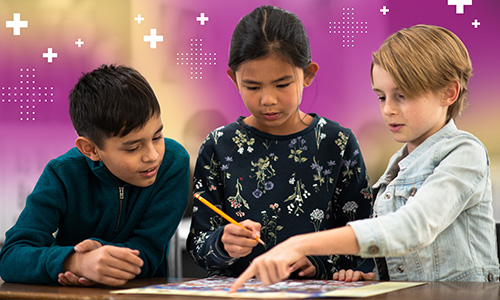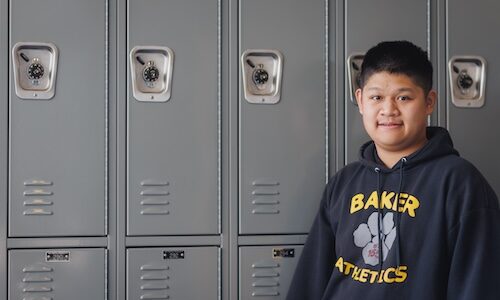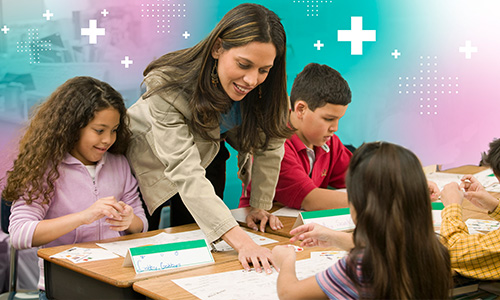In a previous blog, we shared some parent strategies for improving a child’s reading and writing with some tips that they can use throughout the school year. In this post, we’ll share some strategies that parents can use to help their child with math. As holiday and winter breaks approach, these strategies are some ways to continue learning even while everyone is away from school!
Choose two or three of the following strategies and use them throughout the year. They are intended to help increase your child’s understanding of math skills and to develop confidence in learning.
General mathematics improvement strategies
- Provide activities that enrich and relate mathematics to daily life:
- Talk about how many bowls to put out for dinner
- Fold napkins in different shapes
- Have your child count similar items as you put away groceries
- Have your child help measure ingredients for recipes
- Give your child change to count out to pay for small purchases at the store; have older children calculate the change
- Ask your child to compare prices of items by asking things like, “Which can of beans costs more?”
- Allow your child to weigh the fresh produce; have older children calculate the price by multiplying the price per pound by the number of pounds
- Read the days and dates on a calendar, talk about the number of days in the month, the number of days remaining until a special event, etc.
- Draw a scale map of your home and determine the best escape route in case of an emergency
- When traveling, write numbers on a grid and have your child color in the box as they see the numbers on signs or license plates
- Check your child’s assignment list daily
- Monitor daily work and be aware of the content being studied
- Use computer software or online games or apps to practice math skills at home
- Provide some math activities at home:
- Each person rolls the dice and adds, subtracts, or multiplies the numbers
- Dice and Money. Each person rolls a die and gets the number of pennies as dots shown. When someone gets five pennies they trade it in for a nickel, dime, and so forth, until they’re trading for a dollar
- For two people, give each person 13 cards from a deck of cards, have each person flip a card, then have your child decide whose card has the higher value to determine who wins the set of cards. In a tie, place three additional cards face-down, then turn the last card up; the higher card on that turn wins all the cards. Play until one person has all the cards in the deck
- Newspapers and Magazines. Find numbers in print and cut them out, then glue them in the correct order onto a larger sheet of paper
- Keep empty containers, write different prices on them, then play Store by using a calculator to add up the prices for different purchases
Computation
- Count orally by twos, fives, or tens
- Complete connect-the-dot pictures
- Have your child make a number book which contains a page for each numeral from one to ten. On each page, have your child glue clippings from newspapers and magazines illustrating that number concept (two dogs, three ducks, or four horses). As your child progresses with number recognition, they can add to the book and add numerical figures used in various ways
- Count and pair objects found around the house and determine whether there’s an odd or even number of items
- Review math facts at home, in the car, waiting in line, or during other downtime
- Provide your child with verbal math problems. “Take the number five; add six; multiply by three; subtract three; divide by five. What’s your answer?” Speak slowly at first until your child gets better at solving these mental problems
- Help your child identify percentages in signs, newspapers, and magazines
- Encourage your child to read nutrition labels. Have them calculate the percent of a specific nutrient in each item
Geometry
- Fold a sheet of paper in half and have your child draw a shape along the fold; cut out the shape and unfold the paper to create a symmetrical shape
- Look around the house for different geometric shapes, such as triangles, squares, circles, and rectangles
- Use common household items, such as toothpicks, marshmallows, empty toilet paper rolls, twist ties, sticks, and paper, to construct shapes
- Help your child recognize and identify real-world examples of right angles (e.g., the corner of a book) and parallel lines (e.g., railroad tracks)
- While driving together, direct your child to look for objects with the same size and shape
Measurement
- Teach your child how to set the kitchen timer when you’re cooking
- Draw an analog clock face with the hour and minute hands showing eight o’clock. Ask your child to write the time shown
- Arrange various objects (e.g., books, boxes, and cans) by various size and measurement (e.g., length, weight, and volume) attributes. Talk with your child about how they are arranged using comparison words like “taller,” “shorter,” “narrower,” “wider,” “heaviest,” “lightest,” “more,” “less,” “about,” and “same”
- Use a standard measuring tool to measure objects located in your home
- Gather a tape measure, yardstick, ruler, cup, gallon container, and scale. Discuss the various things you can measure with each
- Review equivalent names for measurements. For example, “How many cups are in a pint?”
- Encourage your child to incorporate terms such as “whole,” “halves,” “thirds,” and “fourths” into their everyday life
Statistics, probability, graphing
- Open a pack of Skittles or M&M’s and make a bar graph showing the number of each color found inside the pack
- Look through a science textbook or website and find three examples of different types of graphs
- Find the coordinates of places on a map
- Watch the weather report for a week, write down the temperatures for each day, and then graph the temperatures
- Track the scores of games played by your favorite team, then graph them over a period of several weeks
- Have your child make a list of things that could never happen, things that might happen, and things that are sure to happen
Problem solving
- Encourage your child to figure out answers to real-life situations: “We have one can of tuna and we need five. How many more do we need to buy?”
- Ask questions that involve equal sharing. For example, “Seven children share 49 baseball cards. How many cards does each child get?”
- Help your child look up the population and land area of the state and city in which you live and compare these facts with those of other states and cities
- Visit the website for the U.S. Census Bureau and have your child write down three interesting pieces of information that they learned
Algebraic concepts
- Encourage your child to count and recognize patterns in the environment by discussing what they see:
- What is the number on the house across the street?
- How many objects are left on the table if I take one away?
- How many exits are there from the school building?
- How many swings are on the playground?
- Have your child look for patterns on buildings, rugs, floors, and clothing
- Ask your child how many different ways they can show a specific number, say, 18 (they might say 16 + 2, 19 – 1, 10 + 7 + 1, that sort of thing)
Families play an integral role in education, and these tips can help move your student along in their learning. If you have other math tips, please share them on Twitter with us @NWEA.








